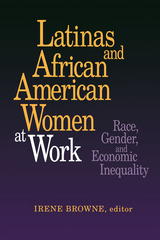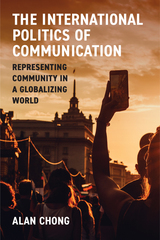2 books about Browne, Irene

Latinas and African American Women at Work
Race, Gender, and Economic Inequality
Irene Browne
Russell Sage Foundation, 1999
One of Choice magazine's Outstanding Academic Books of 1999 Accepted wisdom about the opportunities available to African American and Latina women in the U.S. labor market has changed dramatically. Although the 1970s saw these women earning almost as much as their white counterparts, in the 1980s their relative wages began falling behind, and the job prospects plummeted for those with little education and low skills. At the same time, African American women more often found themselves the sole support of their families. While much social science research has centered on the problems facing black male workers, Latinas and African American Women at Work offers a comprehensive investigation into the eroding progress of these women in the U.S. labor market. The prominent sociologists and economists featured in this volume describe how race and gender intersect to especially disadvantage black and Latina women. Their inquiries encompass three decades of change for women at all levels of the workforce, from those who spend time on the welfare rolls to middle class professionals. Among the many possible sources of increased disadvantage, they particularly examine the changing demands for skills, increasing numbers of immigrants in the job market, the precariousness of balancing work and childcare responsibilities, and employer discrimination. While racial inequity in hiring often results from educational differences between white and minority women, this cannot explain the discrimination faced by women with higher skills. Minority women therefore face a two-tiered hurdle based on race and gender. Although the picture for young African American women has grown bleaker overall, for Latina women, the story is more complex, with a range of economic outcomes among Cubans, Puerto Ricans, Mexicans, and Central and South Americans. Latinas and African American Women at Work reveals differences in how professional African American and white women view their position in the workforce, with black women perceiving more discrimination, for both race and gender, than whites. The volume concludes with essays that synthesize the evidence about racial and gender-based obstacles in the labor market. Given the current heated controversy over female and minority employment, as well as the recent sweeping changes to the national welfare system, the need for empirical data to inform the public debate about disadvantaged women is greater than ever before. The important findings in Latinas and African American Women at Work substantially advance our understanding of social inequality and the pervasive role of race, ethnicity and gender in the economic well-being of American women.
[more]

Precarious Privilege
Race and the Middle-Class Immigrant Experience
Irene Browne
Russell Sage Foundation, 2024
In recent years crackdowns on immigrant labor and a shrinking job market in California, Arizona, and Texas have pushed Latine immigrants to new destinations, particularly places in the American South. Although many of these immigrants work in manufacturing or food-processing plants, a growing number belong to the professional middle class. These professionals find that despite their privileged social class and regardless of their national origin, many non-Latines assume that they are undocumented working-class Mexicans, the stereotype of the “typical Latine.” In Precarious Privilege, sociologist Irene Browne focuses on how first-generation middle-class Mexican and Dominican immigrants in Atlanta respond to this stigmatizing assumption.
Browne finds that when asked to identify themselves by race, these immigrants either reject racial identities entirely or draw on belief systems from Mexico and the Dominican Republic that emphasize European-indigenous mixed race identities. When branded as typical Latines in the U.S., Mexican middle-class immigrants emphasize their social class or explain that a typical Latine can be middle-class, while Dominicans simply indicate that they are not Mexican. Rather than blame systemic racism, both Mexican and Dominican middle-class immigrants often attribute misperceptions of their identity to non-Latines’ ignorance or to individual Latines’ lack of effort in trying to assimilate.
But these middle-class Latine immigrants do not simply seek to position themselves on par with the U.S.-born white middle class. Instead, they leverage their cosmopolitanism—for example, their multilingualism or their children’s experiences traveling abroad—to engage in what Browne calls “one-up assimilation,” a strategy that aims to position them above the white middle class, who are often monolingual and unaware of the world outside the United States. Middle-class Latines’ cosmopolitanism and valuing of diversity also lead them to have cordial relations with African Americans, but these immigrants do not see themselves as sharing African Americans’ status as oppressed minorities.
Although the stereotype of the typical Latine has made middle-class Latine immigrants susceptible to stigma, they insist that this stigma does not play a significant role in their lives. In many cases, they view the stereotype as a minor issue, feel that opportunities for upward mobility outweigh any negative experiences, or downplay racism by emphasizing their class privilege. Browne observes that while downplaying racism may help middle-class Latine immigrants maintain their dignity, it also perpetuates inequality by reinforcing the lower status of working-class undocumented immigrants. It is thus imperative, Browne argues, to repeal harsh anti-immigration policies, a move that will not only ease the lives of the undocumented but also send a message about who belongs in the country.
Offering a nuanced exploration of how race, social class, and immigration status intersect, Precarious Privilege provides a complex portrait of middle-class Latine immigrants in the United States today.
Browne finds that when asked to identify themselves by race, these immigrants either reject racial identities entirely or draw on belief systems from Mexico and the Dominican Republic that emphasize European-indigenous mixed race identities. When branded as typical Latines in the U.S., Mexican middle-class immigrants emphasize their social class or explain that a typical Latine can be middle-class, while Dominicans simply indicate that they are not Mexican. Rather than blame systemic racism, both Mexican and Dominican middle-class immigrants often attribute misperceptions of their identity to non-Latines’ ignorance or to individual Latines’ lack of effort in trying to assimilate.
But these middle-class Latine immigrants do not simply seek to position themselves on par with the U.S.-born white middle class. Instead, they leverage their cosmopolitanism—for example, their multilingualism or their children’s experiences traveling abroad—to engage in what Browne calls “one-up assimilation,” a strategy that aims to position them above the white middle class, who are often monolingual and unaware of the world outside the United States. Middle-class Latines’ cosmopolitanism and valuing of diversity also lead them to have cordial relations with African Americans, but these immigrants do not see themselves as sharing African Americans’ status as oppressed minorities.
Although the stereotype of the typical Latine has made middle-class Latine immigrants susceptible to stigma, they insist that this stigma does not play a significant role in their lives. In many cases, they view the stereotype as a minor issue, feel that opportunities for upward mobility outweigh any negative experiences, or downplay racism by emphasizing their class privilege. Browne observes that while downplaying racism may help middle-class Latine immigrants maintain their dignity, it also perpetuates inequality by reinforcing the lower status of working-class undocumented immigrants. It is thus imperative, Browne argues, to repeal harsh anti-immigration policies, a move that will not only ease the lives of the undocumented but also send a message about who belongs in the country.
Offering a nuanced exploration of how race, social class, and immigration status intersect, Precarious Privilege provides a complex portrait of middle-class Latine immigrants in the United States today.
[more]
READERS
Browse our collection.
PUBLISHERS
See BiblioVault's publisher services.
STUDENT SERVICES
Files for college accessibility offices.
UChicago Accessibility Resources
home | accessibility | search | about | contact us
BiblioVault ® 2001 - 2025
The University of Chicago Press









